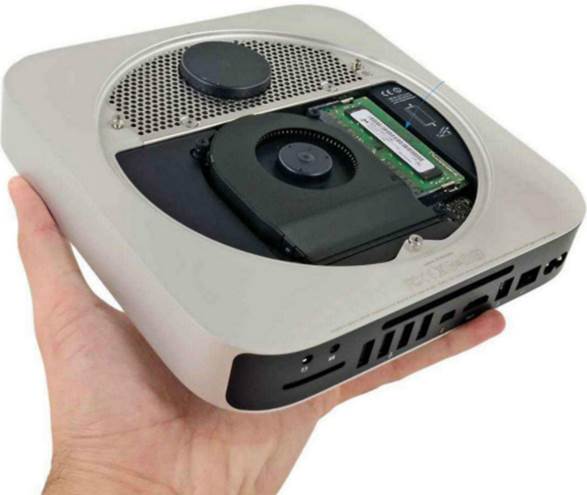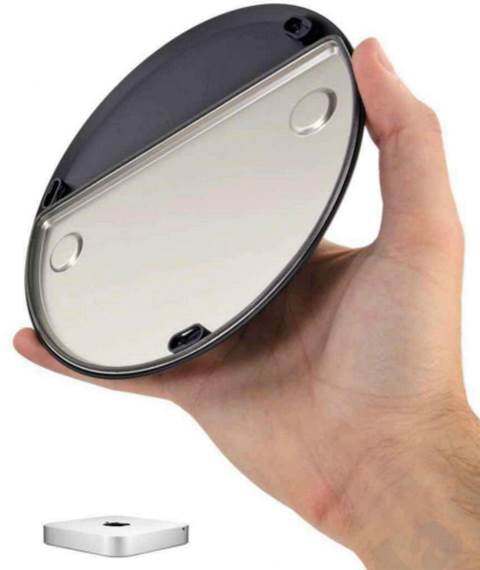The latest Mac mini comes with faster Intel
processors, brand new USB 3ports and the option of Apple’s remarkable Fusion Drive. It’s still easy for anyone to open, and it still starts at under $750.
The diminutive desktop
Mac is still alive and kicking. While the
iMac (when it finally arrives) gets a new blade-like body, and the Retina
MacBooks have shed size and weight, the late 2012 Mac mini remains all but
unchanged on the outside. The precisely crafted aluminium body, with its
gracefully curved corners, shows no signs of change. But on the inside, where
it counts, this is some ways a more capable little beast.

Fancy
a huge 16GB of RAM to keep all your apps running super-smoothly? Clip it in
here for around $75
Like the other Macs released this year, the
mini now comes with Core processors based on Intel’s lvy Bridge architecture.
The memory speed has been increased, too, and there’s new integrated graphics
processor – though still no option for a dedicated GPU. Perhaps the most
pleasing addition of all, for a budget Mac, is that all four of the USB ports
already present on the back panel now run at super-fast USB 3 speeds. If you
want the biggest choice of the fastest peripherals you can get without shelling
out for Thunderbolt, this makes the mini an even more practical choice. As
before, the usual wifi and Bluetooth connectivity is also built in, and the
Gigabit Ethernet and FireWire 800 ports remain present and correct. Apple’s
only corner-cutting here is of the literal variety.
Last year, the more expensive model of mini
had a discrete AMD graphics processor. This time, Apple has settled on an
integrated Intel HD Graphics 4000 series for the whole range; there’s no option
to upgrade this. That makes a certain amount of sense given the 4000’s decent
all-round performance, though, as we’ll see, it’ll leave some users looking to
the iMac to provide the power they need for games and advanced creative
software.
In fact, the two standard configurations
Apple offers now differ in only two regards. The $499 model has a 500GB 5400rpm
hard drive inside, while $1020 gets you a 1TB drive with the same rotational
rating. There’s no official option to change the basic model’s capacity or
speed, although it’s perfectly adequate for many purposes. Thanks to the highly
accessible case design, it’s certainly possible to replace the drive later
yourself – as usual, iFixit.com offers an admirably clear guide – although it’s
buried fairly deep in the mini’s body, and several parts have to be removed to
reach it. For the purposes of your Apple warranty, it isn’t deemed
user-upgradable. So if you do want more capacity without adding cables and
external boxes, consider paying the extra for the higher model.
Besides offering a lot more storage headroom
as standard, this also brings Apple Store build-to-order options for faster but
smaller flash memory-based SSD storage or what could be the best of both
worlds: Apple’s new Fusion Drive. On top of your $1020, swapping the 1TB HDD
for a 256GB SSD will cost you an extra $360. That looks a bit cheeky, given
that similar storage is available for under $225 from other suppliers, but
Apple has a captive audience here: apart from being a pain to install, a
third-party SSD wouldn’t benefit from the TRIM technology that helps such
drives maintain their speed over the long term. You might well start to see
degraded performance once the drive is filled.

No
sealed boxes here: the mini’s base is actually a twist-off lid. If you can get
into a jar of peanuts, you can get into this – in fact, you barely even need an
opposable thumb
A slightly cheaper option, at $300, is the
Fusion Drive. This combines a smaller amount of fast flash storage with a hard
disk, giving you 1TB in total with the promise of substantially increased
performance. We explain all about Fusion over the page, but what we can’t do it
tell you how fast it is in practice, because at the time of going to press
Apple still hadn’t managed to get a sample to us for testing. We’ll have some
results for you in January.
The other difference between the two Mac
mini models lies in their CPUs. In the $750 model is a Core i5 with two cores
running at a clock speed of 2.5GHz, while the $1020 model has a Core i7 with
four cores running at 2.3GHz. Despite the slower clock speed, the extra cores
make this a much more capable processor. If you want more performance again, a
2.6GHz chip costs $120 extra at the time of ordering.
In Cinebench’s single-core CPU-based
rendering test, we found the entry-level mini’s 2.3GHz dual-core i5 was on a
par with the previous 2.5GHz model, thanks to optimizations in Lvy Bridge. The
Core i7 version was faster, but only by a small margin. It’s in multi-core i5
model doesn’t give you a noticeable improvement over the 2011 mini, but the
Core i7 streaks ahead: we saw a 114% increase in score over the i5 in this
benchmark thanks to the i7’s four cores.
With the new lvy Bridge iMacs still on a
slow boat from China at the time of writing, the most logical point of
comparison between the two ranges was the 2.5GHz Core i5 Sandy Bridge iMac from 2011. Here, the faster of the two new Mac minis scored 6.2, comparing very
favorably with the 2011 iMac’s 4.0. This looks like an attractive budget Mac
for intensive tasks that can eat up as much raw processing power as is
available.